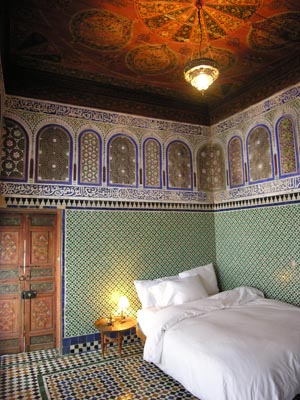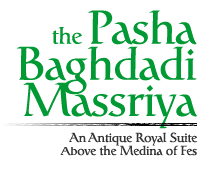| |
 |
 |
 |

More
Photos
Ranked in Top 5 Author's
Picks of Best Places to Stay in Fes by Lonely
Planet
"The medina
apartment to rent”
–
Conde Nast Traveller
|
A remarkable two-story antique royal suite from 1880,
the Massriya of the Pasha Baghdadi is the most beautiful
Massriya we have found in Fez. Decorated with simple
traditional furnishings, the Massriya’s romance comes
from its original architectural detail: the suite
is encrusted with museum-quality carved plaster, original
mosaic, and decorative painting. Authentic, quirky
and romantic.
- Two master bedrooms, including rooftop jewelbox
"Menzeh" encrusted from mosaic floor to painted
ceiling with museum-quality decorative detail,
opening onto the terrace and city view from bed.
Separate Menzeh is accessed through outside staircase.
- Small Garden Room on main floor contains ornate
traditional fountain, small traditional domed
Hammam bath designed for 4 people, and a shared
bathroom.
- Large Salon with high original painted ceiling
and cascading antique carved plaster.
- Rooftop terrace with medina view.
- Excellent accessible location in medina.
- Tiny kitchenette in
Garden Room.
- Dramatically lit, with simple traditional furnishings.
- Down comforters, Italian linen and Egyptian
cotton sheets and towels, and hand-embroidered
wool, alpaca, and silk djellaba robes.
|
|
|
|
|
|
 |
 |
|
|
|
| To
print the full details of the Pasha Baghdadi
Massriya, click
here. |
|
| |
|
|
| |
|
“Not sure where I should begin, or where
I'll find the words for that matter, to say thank you for making
our trip to Morocco a wonderful experience. The trip was much
more than I had ever imagined. The Massriya was a crowning touch.
Absolutely grand and stunning yet warm and welcoming. We enjoyed
our time in Fez immensely.”
More
Testimonials about the Massriya
|
|
|
| Originally
the jewel of the house of the Pasha Baghdadi, who administered justice
in Fez in the late 1800's, this suite is itself an antiquity. Its
carved plaster in delicate hues has been untouched since 1880. Exceptionally
fine mosaic extends throughout the suite. The spacious main salon
has a high ceiling completely covered in original decorative painting
from which carved plaster falls like lace in an incredible virtuosity
of design. A poem carved into the plaster circles the room and welcomes
the guest into the suite. Through an arched doorway is the first master
bedroom, with a view of the Merenid tombs on the hillside. Below the
window, the life of the old city goes on uninterrupted, with the musical
cries of the mint-seller in the morning to the sound of old men leading
leather-laden mules downward into the Medina. Here,
the call to prayer sounds five times each day through your window.
We have restored this suite as an authentic experience of Moroccan
tradition – then added special touches rare in Morocco – from Egyptian
cotton sheets and towels to down comforters and pillows to hand-embroidered
wool and silk bathrobes in the traditional style. The furniture is
traditional and simple, and the dramatic lighting draws attention
to the original detail that gives the site its allure.
A Small Garden
Room Contains an Intimate Domed Hammam Bath
On one side of the Grand Salon is a small, dramatically-lit
Garden Room with an ornate mosaic suquaia wall fountain. Bathe in
the intimate domed tadelakt and mosaic hammam. Created by Hussein
Kadiri, the chief architect for the restoration of the Bou Inania
Medersa, this hammam – designed for four people - brings to life the
traditional Moroccan community bath, created to welcome the guest
for hours. Centered by its fountain, the Garden Room is the only space
that we have altered in our restoration of the Pasha Baghdadi Massriya.
Once a half-built modern kitchen, the space was adapted to fill the
traditional role of the wust dar, the symbolic center of the house,
with its water source centered on the main axis of the suite and visible
through successive arches. Step out of the hammam and rest in luxurious
embroidered robes created by the skilled hands of Moroccan women still
practicing the art of clothing kings.
The Jewelbox Menzeh & the Roof Terrace
Quirkily situated at the crown of the house one floor above the main
Salon level, and accessed through the common stairway, you will find
the most remarkable room in the Pasha Baghdadi complex - the Jewelbox
"Menzeh", the likes of which we have never seen in our extensive exploration
of traditional houses in Fez. The rooftop Menzeh bedroom is a room
completely encrusted with original antique decoration. From floor
to ceiling, every inch of the nine-by-nine foot space is embellished
with extraordinary workmanship. The mosaic continues from the floors
up the walls until it meets antique carved plaster studded with stained
glass. Above this is an ornately painted ceiling in warm reds and
ochres. The effect is astounding. Three large windows look out onto
the terrace, creating a bright rooftop garden retreat by day. By night,
the light from the Menzeh illuminates the deep jeweled shades of the
stained glass windows where tiny missing panes and broken plaster
cast lacy shadows out onto the terrace. We will not repair the lovely
webbed plaster where it has broken. We will not remove the tiny abandoned
mud wasp’s nest from the sharp carved starburst of the Menzeh’s antique
plaster. All of this is part of the baraka or fortuitous blessing
of the Menzeh, which we have preserved as it was found, a jeweled
secret place at the crown of the Fez medina. The Menzeh bedroom shares
the bathroom on the floor below, which is accessed along the common
stairway. Despite this inconvenience, groups of four will battle each
other to claim the Menzeh bedroom where, just sitting up in bed, one
can look out over the moonlit terrace to the lights of Fez.
The Massriya’s roof terrace, studded with pots of rosebushes and lavender,
provides a simple retreat above the life of the city, ideally located
to hear the call to prayer echo from the many minarets in the Fez
medina, to eavesdrop on the passing pedestrians below, to view the
stunning Fez sunset or to enjoy a lantern-lit dinner under the stars.
The terrace is shared with two neighboring families, and while we
rarely have the opportunity to meet them there (terraces are the territory
of women and unfortunately ours is almost never used), there is a
small chance that you will have the opportunity to meet the women
of the house.
A Small Kitchen Corner is Cached
in the Garden Room
Convenient for limited cooking, a small kitchen corner is
hidden in the Garden Room. The kitchen corner contains a small refrigerator,
a marble sink, hotplate surfaces, silverware and dishes and a small
set of pots and pans.
Location of the Pasha Baghdadi Massriya
The Pasha's Massriya is optimally located off Talaa el Kebira,
a major thoroughfare in the Fez Medina, a five-minute walk from the
only taxi entrance on this side of the Medina. It is also only five
minutes from both Moulay Idriss, the Bou Inania Medersa, and Bab Boujeloud,
the most popular tourist entrance to the Fez Medina.
Like all Massriyas, the Pasha Baghdadi Massriya is located at the
top of the house and up three flights of stairs, sharing a stairway
with other Moroccan families. Unlike a luxury hotel, the Massriya
is not separated from the real Moroccan community, and the main floor
of the Massriya is located within the sounds of the authentic life
of the old city of Fez. Perched above the true sounds and experiences
of the Medina, you will hear children playing in the souks and in
the apartments around you. The Menzeh and the rooftop terrace are
quiet retreats above the city.
The Restoration of the Pasha Baghdadi
Massriya
The restoration of the Pasha
Baghdadi Massriya has been pursued with great respect for the priceless
antiquity of the suite. We have left the gorgeous aged plaster in
its original excellent condition, not attempting to over-clean or
paint it to make it look new. We value the faded eggshell color of
centuries-old plasterwork with its original tempera colors over the
too-white gleam of "restored" plaster.
Our team has worked meticulously to remove the modern overpainting
marring the historic doors of the Menzeh, the window frames, and the
ceilings in the bathroom and stairwell. We want to see the scars on
the old wood. In places where the original plaster was heavily overpainted,
one man worked for a day to reveal just one foot of the original detail,
deftly chipping away the paint, taking great care to preserve the
original powdered pigment that gives the crevices of the plaster its
depth and color. Traditional ironsmiths in the souk have matched the
original iron grillwork in the windows (we dare you to tell the new
from the old). Our electrician laughed at us as we salvaged the Massriya’s
antique light switches and scoured the souk for more. We puzzled the
plumber as we refused modern faucets in favor of simple brass twists
used for community fountains. The coppersmith in Seffarine no doubt
thought we were crazy as we asked him to dig out every copper spigot
in his shop. He saw tarnished overflows from copper stills created
to distill flower essences. We saw spigots for the garden room.
Through the restoration of the Massriya, our goal has been to reveal
what has always been there. While we have stabilized critical structural
points and wholly replaced the antiquated electrical and water systems,
everything that is old and beautiful must stay. Where the modern must
intervene, we have tried to interpret in traditional materials. This
aesthetic is rare in Morocco today, where many of the historic hotels
have been renovated with shiny pink marble and synthetic tapestry.
There is more to do in the Massriya – a full restoration is the work
of years. The next restoration phase must include the careful repair
of several small areas of deep damage in the plasterwork and mosaic.
This is delicate work because the cost of a mistake is so high – once
the integrity of the original is destroyed it can never be replaced,
and it is not in our aesthetic to recreate. We are currently researching
the original pigments that would have been used in the crevices of
the carved plaster in 1880 so that in areas where the pigment has
been destroyed we might subtly restore some of the lustrous, matte
lapis blue of the original. Each stage of the restoration work is
a discovery – we learn from both our successes and our mistakes. The
mistakes we agonize over at length. Simultaneously during this adventure
we feel the daunting responsibility, the thrill, and the enormous
privilege of working with so detailed, so enthralling, so spectacularly
condensed an example of Islamic art.
|
|